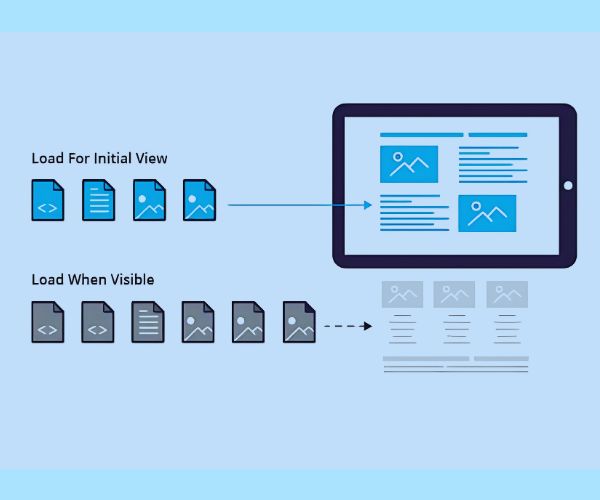When you visit a website, you expect it to load quickly, right? But what if the site has dozens of high-resolution images, videos, and other heavy media? This can slow things down – unless the website uses a smart technique called lazy loading.
Let’s explore what lazy loading is, why it matters, and how it can improve your site’s speed, user experience, and even your Google ranking.
What Is Lazy Loading?
Lazy loading is a website optimization technique that delays the loading of non-essential resources (like images or videos) until they’re actually needed.
In simple terms: instead of loading everything on the page right away, the browser waits to load items until the user scrolls to them.
Example:
Imagine a blog post with 20 images. With lazy loading:
- Only the images visible on the screen load initially.
- As the user scrolls down, the rest load when needed.
This makes your site load faster upfront, especially for users on mobile devices or slow internet.
Why Your Website Needs Lazy Loading
1. Improves Page Speed
The fewer elements the browser loads at once, the faster your page becomes interactive. Lazy loading cuts initial load time drastically.
2. Better Core Web Vitals (Especially LCP & CLS)
- Largest Contentful Paint (LCP): Lazy loading helps LCP by not overloading the browser with large image files early on.
- Cumulative Layout Shift (CLS): Prevents layout jumps caused by late-loading images.
Check here How Poor Core Web Vitals Can Hurt Your Google Rankings
3. Boosts SEO and Google Rankings
Page speed is a confirmed ranking factor. Google prioritizes fast-loading websites. Lazy loading helps improve that without sacrificing design.
4. Enhances Mobile Experience
Mobile users have less bandwidth and smaller screens. Lazy loading ensures their experience stays smooth and snappy.
5. Saves Bandwidth
Why load images the user may never scroll to? Lazy loading saves data – great for users on limited plans.
How Lazy Loading Works
There are a few ways lazy loading is implemented:
HTML loading attribute
Example:
html
CopyEdit
<img src=”image.jpg” loading=”lazy” alt=”…” />
- JavaScript-based lazy loading using libraries or custom scripts
- WordPress and CMS plugins (like WP Rocket or Smush)
Most modern browsers (like Chrome, Firefox, and Edge) support lazy loading natively using the loading=”lazy” attribute.
When and What to Lazy Load
Best candidates for lazy loading:
- Images (especially below the fold)
- Videos
- Iframes (like embedded YouTube content)
- Background images or sliders
Do NOT lazy load:
- Logos and header images
- Above-the-fold visuals (what the user sees first)
- Critical UI elements like buttons or menus
How to Add Lazy Loading to Your Website
👉 WordPress:
Install plugins like:
- WP Rocket
- Lazy Load by WP Rocket
- Smush
These plugins require minimal setup and start working automatically.
👉 Manual HTML:
Add loading=”lazy” to your image tags.
👉 JavaScript:
Use libraries like lozad.js, lazysizes, or custom IntersectionObserver API logic.
Common Lazy Loading Mistakes
- Lazy loading above-the-fold content (hurts performance and LCP)
- Using unsupported browsers without fallback
- Poor implementation causing images not to load at all
- Skipping alt text for lazy-loaded images (bad for accessibility)
Related FAQs
❓ Does Lazy Loading Help SEO?
Yes. Faster loading pages rank better in search engines. Google supports lazy loading – if implemented properly.
❓ Is Lazy Loading Good for Mobile Sites?
Absolutely. It speeds up load time and saves mobile data – making it ideal for mobile-first design.
❓ What Is the Difference Between Lazy Loading and Eager Loading?
- Lazy loading loads assets only when needed.
- Eager loading loads all assets as soon as the page loads – which can slow down performance.
❓ Can Lazy Loading Break My Website?
If implemented incorrectly, yes. Always test thoroughly – especially on mobile and across browsers.
Final Thoughts
Lazy loading is one of the easiest and most effective ways to improve your website’s performance, user experience, and SEO. It reduces unnecessary data loading, speeds up your page, and helps with important metrics like Core Web Vitals.
If your site has a lot of media content – images, videos, galleries – lazy loading is no longer optional. It’s essential.


